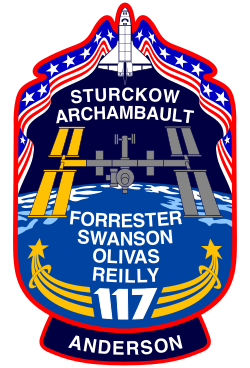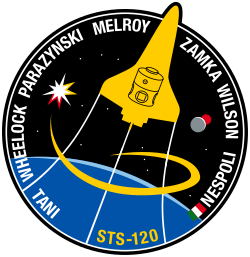Clayton Anderson
| Clayton Conrad Anderson | |
|---|---|
 | |
| Astronaut NASA | |
| Státní příslušnost | Spojené státy americké |
| Datum narození | 23. února 1959 (63 let) |
| Místo narození | Omaha, Nebraska, Spojené státy americké |
| Předchozí zaměstnání | inženýr |
| Čas ve vesmíru | 151d 18h 23m |
| Kosmonaut od | 1998 |
| Mise | STS-117, Expedice 15, Expedice 16, STS-120 |
| Znaky misí | |
| Některá data mohou pocházet z datové položky. | |
Clayton Conrad Anderson (* 23. února 1959, Omaha, Nebraska, Spojené státy americké) je americký astronaut, který pracoval v roce 2007 na Mezinárodní kosmické stanici ISS. Má přezdívku Clay.
Životopis
Středoškolské vzdělání získal v roce 1977 na Ashland-Greenwood High School v Nebrasce, vysokoškolské studium zdárně ukončil roku 1981 v oboru fyziky na Hastings College a letectví na Iowa State University. Zde výuku zakončil v roce 1983 a nastoupil k NASA v Houstonu. Pracoval zde na různých místech. Byl mj. členem podmořského týmu NEEMO, sestaveného NASA.[1] Do výcvikového střediska astronautů byl zapsán v roce 1998, po absolvování výcviku byl zařazen do jednotky astronautů. Do vesmíru letěl v roce 2007 a strávil zde tři měsíce.
Je ženatý se Susan Jane, rozenou Harreldovou a mají spolu dvě děti – syna Coleho a dceru Marii.
Let do vesmíru
V červnu 2007 byl členem posádky raketoplánu Atlantis. Raketoplán při svém 28. letu (dle COSPAR 2007-024A) odstartoval tradičně z kosmodromu na Mysu Canaveral na Floridě. Na palubě spolu s ním letěli: Frederick Sturckow, Lee Archamebaulf, Patrik Forrester, Steven Swanson, John Olivas a James Reilly. Anderson byl do posádky nominován dodatečně a po odletu Atlantisu na stanici zůstal jako člen Expedice 15, kde vystřídal Sunitu Williamsovou. Po příletu další dlouhodobé posádky v říjnu 2007 se stal na několik týdnů členem Expedice 16.
Anderson byl v pořadí 457. člověkem ve vesmíru, kam letěl jen jednou, v kosmu strávil 151 dní. Během pobytu na stanici absolvoval tři mnohahodinové výstupy (EVA) na její povrch, strávil na montážních pracích ve skafandru 18 hodin. Zpátky na Zem se vrátil s misí STS-120.
Odkazy
Reference
- ↑ I jednoduché věci jsou těžké. Letectví a kosmonautika. 2008, roč. 84, čís. 8, s. 77. ISSN 0024-1156.
Externí odkazy
 Obrázky, zvuky či videa k tématu Clayton Anderson na Wikimedia Commons
Obrázky, zvuky či videa k tématu Clayton Anderson na Wikimedia Commons - Andrerson na MEK
- Mise STS-117
- Anderson na SPACE 40
Média použitá na této stránce
ISS016-S-001A (February 2007) --- This patch commemorates the sixteenth expeditionary mission to the International Space Station (ISS). The design represents the conjunction of two unique astronomical events: a transit of the ISS across the surface of a full moon, and a nearly complete annular eclipse of the sun. The ISS is shown in its complete configuration, symbolizing the role of this expedition in preparing for the arrival and commissioning of international partner modules and components. The ISS transit across the moon highlights its role in developing the techniques and innovations critical to enable long-duration expeditions to the lunar surface and beyond. The NASA insignia design for shuttle and space station flights is reserved for use by the astronauts and for other official use as the NASA Administrator may authorize. Public availability has been approved only in the form of illustrations by the various news media. When and if there is any change in this policy, which is not anticipated, it will be publicly announced.
The operational teamwork between human space flight controllers and the on-orbit crew take center stage in this emblem. Against a backdrop familiar to all flight controllers, past and present, independent of any nationality, the fifteenth expedition to the ISS is represented in Roman numeral form as part of the ground track traces emblazoned on the Mercator projection of the home planet Earth. The ISS, shown in its fully operational, assembly complete configuration, unfurls and then reunites the flags of this Russian and American crew in a show of our continuing international cooperation. Golden spheres placed strategically on the ground track near the flight control centers of the United States and Russia serve to symbolize both the joint efforts from each nation's team of flight controllers and the shuttle and Soyuz crew vehicles in their chase orbit as they rendezvous with the ISS. A rising sun provides a classic touch to the emblem signifying the perpetual nature of manned space flight operations and their origin in these two space-faring nations. The NASA insignia design for shuttle and space station flights is reserved for use by the astronauts and for other official use as the NASA Administrator may authorize. Public availability has been approved only in the forms of illustrations by the various news media. When and if there is any change in this policy, which is not anticipated, the change will be publicly announced.
The STS-117 crew patch symbolizes the continued construction of the International Space Station (ISS) and our ongoing human presence in space. The ISS is shown orbiting high above the Earth. Gold is used to highlight the portion of the ISS that will be installed by the STS-117 crew. It consists of the second starboard truss section, S3/S4, and a set of solar arrays. The names of the STS-117 crew are located above and below the orbiting outpost. The two gold astronaut office symbols, emanating from the '117' at the bottom of the patch represent the concerted efforts of the shuttle and station programs toward the completion of the station. The orbiter and unfurled banner of red, white and blue represent our Nation's renewed patriotism as we continue to explore the universe.
The STS-120 patch reflects the role of the mission in the future of the space program. The shuttle payload bay carries Node 2, the doorway to the future international laboratory elements on the International Space Station. On the left the star represents the International Space Station; the red colored points represent the current location of the P6 solar array, furled and awaiting relocation when the crew arrives. During the mission, the crew will move P6 to its final home at the end of the port truss. The gold points represent the P6 solar array in its new location, unfurled and producing power for science and life support. On the right, the moon and Mars can be seen representing the future of NASA. The constellation Orion rises in the background, symbolizing NASA's new exploration vehicle. Through all, the shuttle rises up and away, leading the way to the future.




